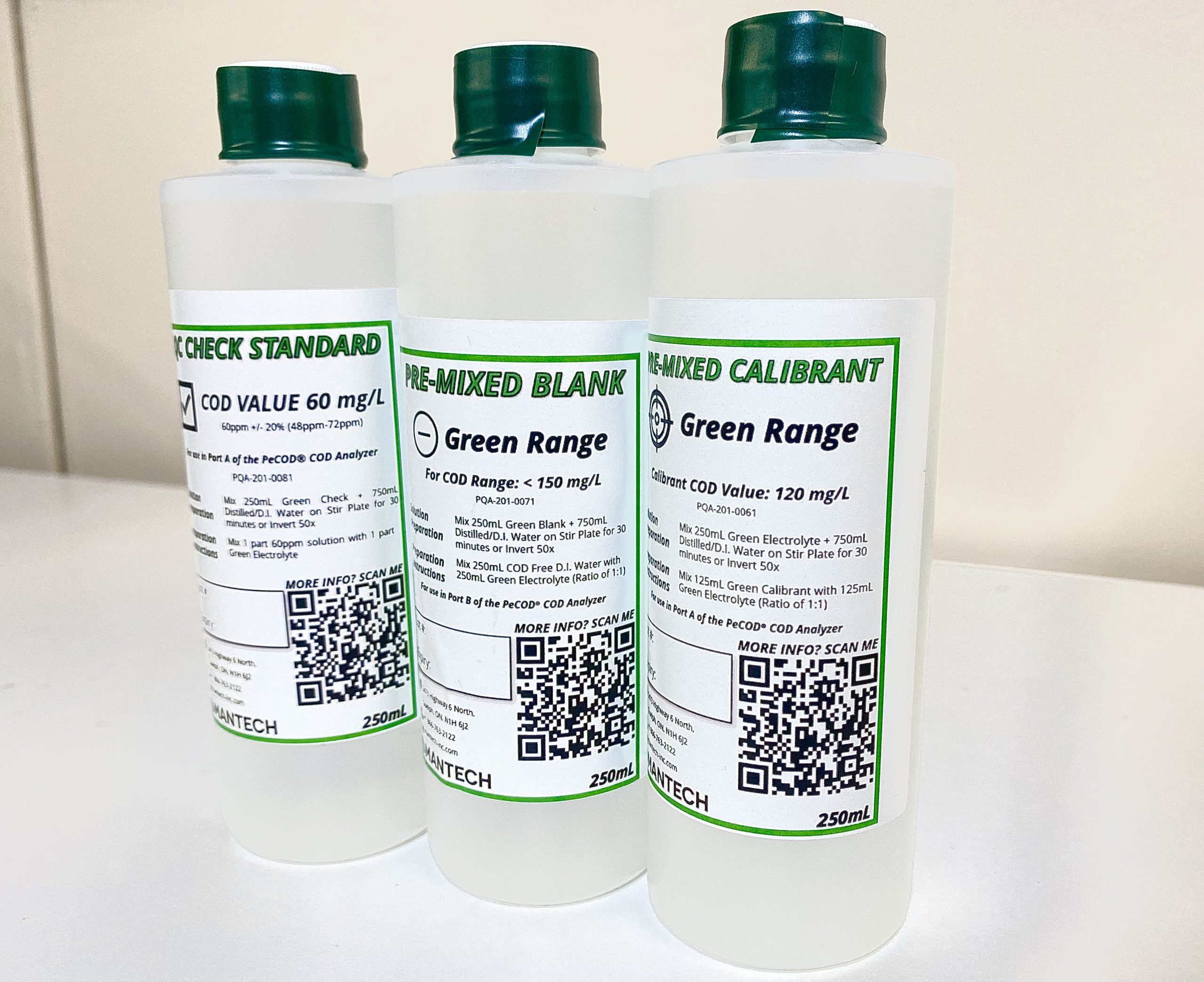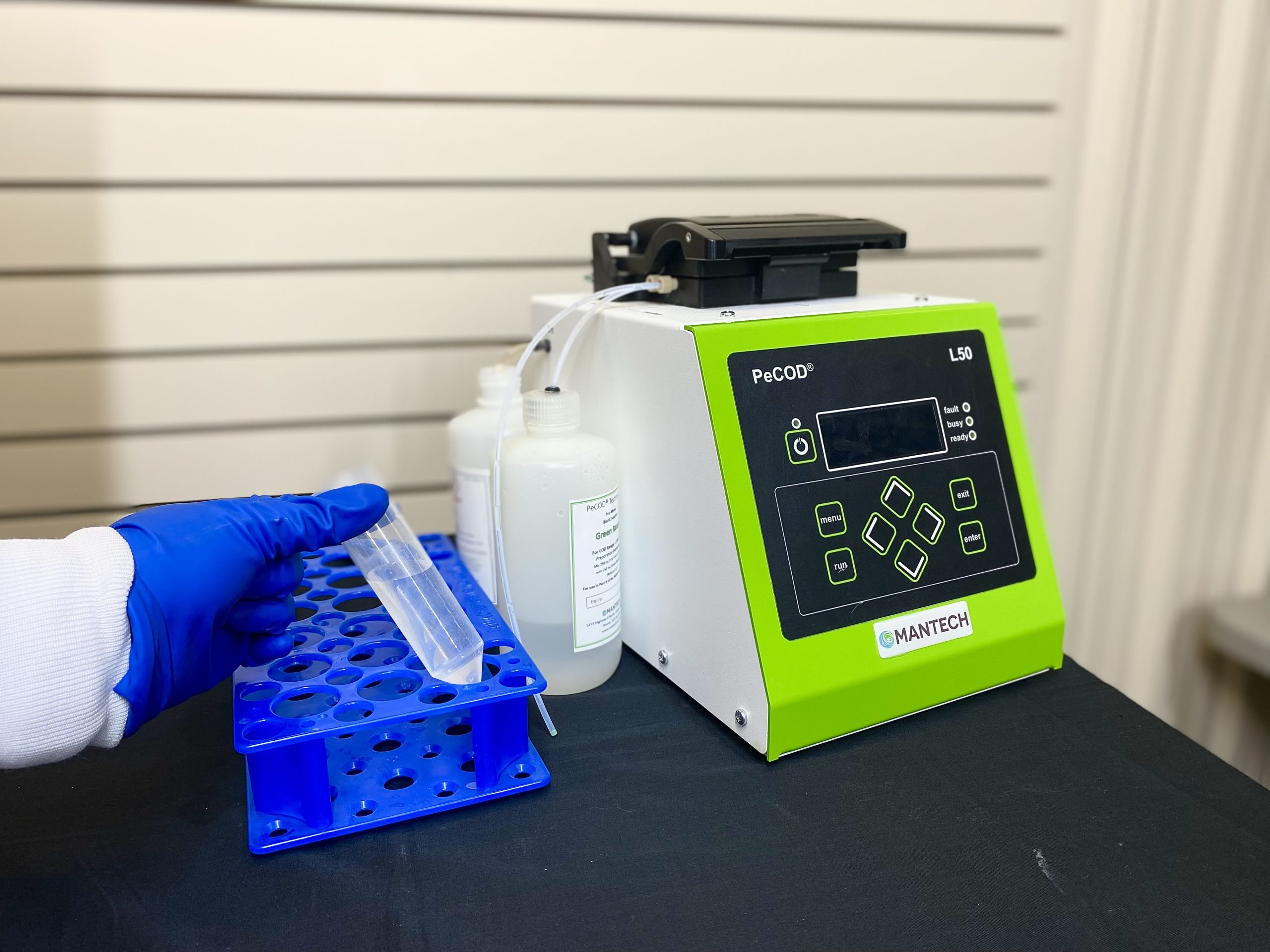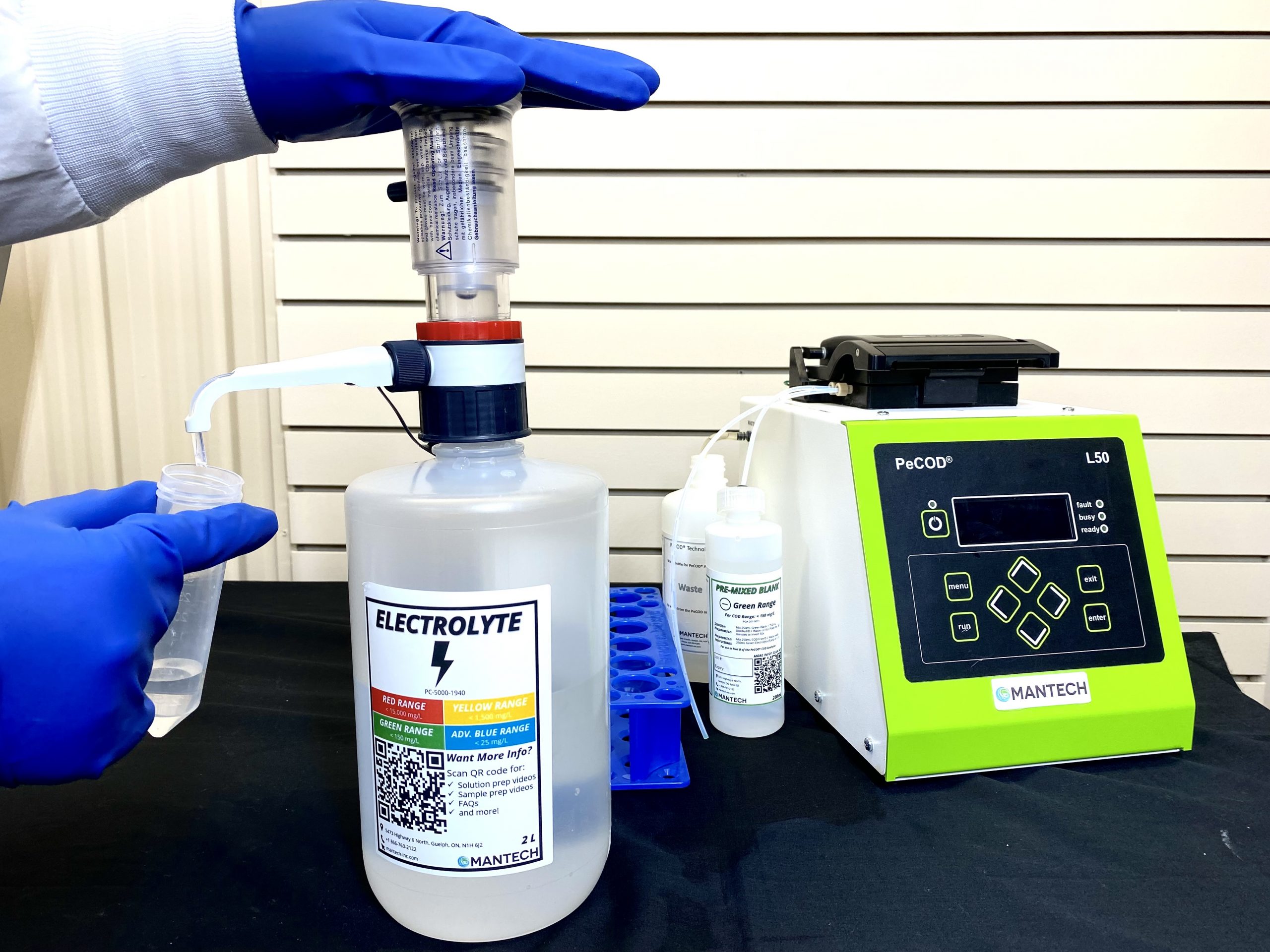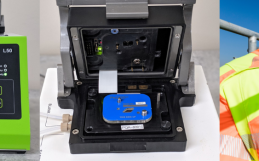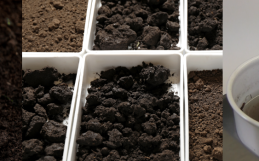- How much do the PeCOD solutions weigh?
Solution Type Weight (g) 1L Electrolyte (Adv. Blue Range) 1400 g 500mL Electrolyte (Green, Yellow and Red Ranges) 647 g 250mL Calibrant (All Ranges) 312 g 250mL Blank (All Ranges) 314 g 250mL Check Standard (All Ranges) 311 g - Why did the PeCOD® solutions change?
The formulations of the electrolyte, calibrant, blank, QC check solutions have not changed. By adding deionized or distilled water on-site vs. prior to shipping we have reduced the size and weight of the shipped bottles by up to 75%. This aims to reduce shipping costs, carbon emissions, and plastic waste which translates to a reduction in your cost per sample and carbon footprint.
- What do the Just Add Water solutions mean for existing PeCOD® customers?
The formulation of the electrolyte, calibrant, blank and QC check solutions has not been altered. The Just Add Water solutions are a concentrate only requiring the addition of deionized or distilled water. MANTECH is offering a special discounted supply kit for existing PeCOD® customers which includes:
- 250mL plastic squeeze bottle
- 1/2 gallon jug, 500mL graduated cylinder
- Funnel
- 4x 1L plastic sample bottles with caps
- 1/4″ Grommet (for 1L bottle caps) for waste and QC Check Standard bottles
- Set of labels for empty bottles (Electrolyte, Calibrant, Blank, QC Check Standard and Waste)
- Straw for bottle top dispenser
Please contact MANTECH to order your supply kit here.
- What is the difference between the previous solutions and the Just Add Water solutions?
The Just Add Water electrolyte, calibrant, blank and QC check solutions contain all solutes typically present in our previous solutions and will only require the addition of the respective amount of water (deionized or distilled). This was done with the aim of reducing shipping costs and carbon emissions through a reduction in the amount of water present in the solution.
- What is the acceptance range for MANTECH's pre-mixed secondary standards?
The acceptable range for MANTECH’s pre-mixed secondary standards is ±20%.
- Does PeCOD® require filter or homogenizer for samples with large particles?
For samples containing particles larger than 50μm, a pre-filtration or homogenization step is required. For biochemical oxygen demand (BOD) analysis, a simple pre-filtration step is required. For chemical oxygen demand (COD) analysis, no filtering required as we recommend a homogenizer that gets all particles to a 1micron size. We use the below:
PRO200 Homogenizer with SS Probe – This is our base model and setup can be used within 5ml-50ml tubes with sample piece size of 10mm or less or liquid base sample up to 100ml. (MANTECH part number: PCH-4000-197)
PRO250 Homogenizer with SS Probe – When there is a more viscous/thick or larger solid sample piece over 10mm, our 20mm X 115mm SS Probe would be needed. This homogenizer & probe setup can cover 50ml-500ml tubes/beakers. Other probes can be used with this Homogenizer for even larger volumes. (MANTECH part number: PCH-4000-198)
Homogenization can be automated using the autosampler arm and in our online analyzer.
- How can I make Calibrant and Check Standard solutions?
View our instructions for producing 1L calibrants, check standards and for more information on these solutions: https://mantech-inc.com/wp-content/uploads/2020/09/1-L-calibrant-instruction.pdf
- How do I prepare my water/wastewater sample for PeCOD Analysis using a homogenizer?
The following steps will outline how to correctly homogenize a water/wastewater sample for analysis with the PeCOD.
- Homogenize the raw sample for 2 minutes. Ensure you are using at least 50mL or more of sample.
- Prepare the sample with electrolyte in the range being used. Click here for the correct sample-to-electrolyte ratio for each colour range.
– For example, if you are using yellow range, take 2mL of sample plus 18mL of electrolyte.
– If dilution is required, prepare the dilution first with the homogenized sample, then prepare with electrolyte. - Homogenize the mixture of sample and electrolyte for 1 minute.
- Place the PeCOD intake tube (Port A) into the sample and press run the analysis.
- Rinse the homogenizer in deionized water, turn on for 30s while in DI water.
- Spray down homogenizer with DI water using a laboratory bottle with nozzle (common lab squeeze bottles).
- How many PeCOD samples can be analyzed with the reagent starter kit I received?
New PeCOD Analyzer orders typically include a slurry reagent starter kit providing the consumables to run the PeCOD analysis. These kits consist of Electrolyte, Calibrant, and Secondary Standard slurry reagents. Electrolyte is the reagent that is mixed with each sample, therefore it is typically the reagent to be used up first, requiring the user to purchase more from MANTECH. It is useful to know on average how many samples can be run with the electrolyte provided in the standard reagent starter kits, therefore we provide this information below.
You will need to know the color operating range of your PeCOD (Adv. Blue, Green, Yellow, or Red). If you plan to run a single analysis per sample, use the left column for 10mL total volume. If you require duplicate or triplicate analysis per sample, use the right column for 20mL total volume. Depending on how many samples are run per calibration, these numbers may vary.
10mL Total Volume – Single Analysis 20mL Total Volume – Duplicate and Triplicate Analysis For Advanced Blue range (3:1): - 7.5mL sample required
- 2.5mL electrolyte required
- 2L electrolyte provided in starter kit
- 800 samples can be run
For Advanced Blue range (3:1): - 15mL sample required
- 5mL electrolyte required
- 2L electrolyte provided in starter kit
- 400 samples can be run
For Green range (1:1): - 5mL sample required
- 5mL electrolyte required
- 2L electrolyte provided in starter kit
- 400 samples can be run
For Green range (1:1): - 10mL sample required
- 10mL electrolyte required
- 2L electrolyte provided in starter kit
- 200 samples can be run
For Yellow range (1:9): - 1mL sample required
- 9mL electrolyte required
- 2L provided in starter kit
- 222 samples can be run
For Yellow range (1:9): - 2mL sample required
- 18mL electrolyte required
- 2L provided in starter kit
- 111 samples can be run
For Red range (1:49): - 0.2mL sample required
- 9.8mL electrolyte required
- 2L provided in starter kit
- 204 samples can be run
For Red range (1:49): - 0.4mL sample required
- 19.6mL electrolyte required
- 2L provided in starter kit
- 102 samples can be run
Number of samples that can be run with 10L bottle of electrolyte: - Adv. Blue range, 4000 samples
- Green range, 2000 samples
- Yellow range, 1111 samples
- Red range, 1020 samples
Number of samples that can be run with 10L bottle of electrolyte: - Adv. Blue range, 2000 samples
- Green range, 1000 samples
- Yellow range, 555 samples
- Red range, 510 samples
Note: 5x Electrolyte slurry packages are required for making up 10L. - What are the PeCOD electrolyte and calibrant solutions composed of?
The PeCOD electrolyte solution is mainly composed of a low-concentration lithium nitrate solution. The PeCOD calibrant and check standard solutions supplied by MANTECH are composed of sorbitol. These solutions contain a trade recipe preservative that allow for the longer shelf life, compared to solutions prepared manually. Calibrant and check standard solutions prepared manually, following the PeCOD Standard Recipe, can be used for up to two weeks.
View the PeCOD electrolyte slurry SDS here.
View the PeCOD calibrant slurry SDS here.
View the PeCOD QC check standard slurry SDS here.
View the PeCOD blank slurry SDS here.
- Do I need to filter my samples for PeCOD analysis?
Samples must be filtered prior to peCOD analysis to ensure that no particulates greater than 50 micron (um) are primed into the peCOD. Particulates larger than 50um can cause clogging, which can lead to damage of the internal fluidics of the machine. To prevent clogging and ensure proper sample preparation, MANTECH has a Sample Filtering Guide for PeCOD Analysis.
For pulp and paper and wastewater applications, MANTECH recommends using a 35um polyethylene (PE) syringe filter. These filters can contribute trace amounts of organics, which are negligible for wastewater applications. For drinking and source water applications it’s important to use a filter that does not contribute organics to the filtered sample. One of MANTECH’s research partners has recommended a 0.45um polyethersulfone (PES) filter; however, other filter types may also be acceptable, if no organics are contributed by the filter. Since these applications traditionally see less particulates, having a smaller pore size filter hasn’t shown an impact on the peCOD results.
- What are the COD/BOD ranges for the PeCOD and what are the mixing ratios?
There are 4 COD ranges for the PeCOD. The advanced blue range is the lowest range and analyzes samples up to 25mg/L with a mixing ratio of 3:1 (sample to electrolyte). Green is the second lowest range and measures up to 150mg/L with a mixing ratio of 1:1. The yellow range determines COD up to 1,500mg/L with a mixing ratio of 1:9 and the red range can analyze samples up to 15,000mg/L and has a mixing ratio of 1:49. For more information, read MANTECH’s technical bulletin here.
- How long will the PeCOD® Electrolyte, Calibrant, and Standard solutions last?
Both Calibrant and Standard Solutions are good for one year after they are made. Electrolyte has a shelf life of two years after it is produced. All labels have the expiry date in the box just above the MANTECH logo.
Eco-Conscious Just Add Water PeCOD® Solutions
MANTECH is excited to announce PeCOD®’s Just Add Water solutions! Featuring the exact same formula, these concentrated solutions simply require customers to add water (deionized or distilled – found at your local grocery store). By adding water after shipping, we have cut the volume and weight of the bottles by up to 75% thereby reducing plastic waste, shipping costs, and carbon emissions. On top of all that, production efficiencies have led to improved pricing for the Blank, Calibrant, and QC Check solutions. These solutions not only reduce your cost per sample but also strengthen MANTECH’s commitment to making water, soil, and food quality analysis faster, simpler and GREENER.
Concentrating the solutions has reduced plastic bottle sizes by up to 75%! MANTECH’s provides all customers with 2L (for electrolyte) and 1L (for blank, QC check, and calibrant) plastic bottles that can be reused for each batch.
Concentrating the solutions has reduced the weight of the bottles by up to 75%! As shipping costs are determined by shipment weight, this not only reduces your cost per sample but also reduces your carbon footprint.
MANTECH has recognized improved production efficiencies through PeCOD®’s Just Add Water reagents, leading to improved pricing on Blank, Calibrant, and QC Check solutions for our customers.
Preparation of the solutions takes minutes! Simply add the concentrated solution and appropriate amount of water to the MANTECH provided reusable bottle (either 1L for blank, QC check and calibrant solutions or 2L for electrolyte solution).
Solution Preparation Tutorial Videos
View PDF instructions here.
Electrolyte Solution
Step-by-step tutorial videos on how to make 2L of PeCOD® electrolyte solution.
Calibrant, QC Check, & Blank Solutions
Step-by-step tutorial videos on how to make 1L of PeCOD® calibrant, QC check, and blank solutions.
Sample Preparation Tutorial Videos
As PeCOD uses microfluidics all samples cannot contain particles larger than 50μm. For strong CODcr correlation, MANTECH recommends a pre-homogenization step using a high sheering mechanical homogenizer. In fact, if following ISO, EPA, ASTM or APHA Standard Methods for COD analysis, a homogenizer is specified in the method. For BOD analysis and correlation, MANTECH recommends a pre-filtration step.
Step-by-step tutorial video on how to prepare a sample for PeCOD® analysis with filtration step.
Step-by-step tutorial video on how to prepare a sample for PeCOD® analysis with pre-homogenization step.

